Mapping the World of Barbecue
Global flavors, regional variations, and interesting flavor combinations are punching up the barbecue sauce category.
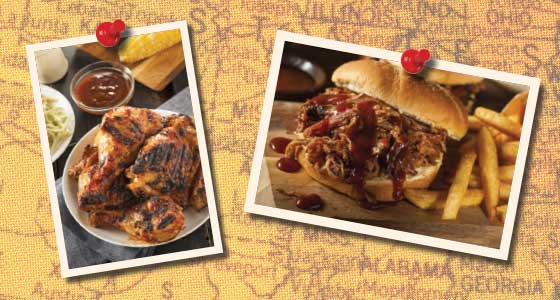
Barbecue might just be America’s national food. It enjoys broad popularity across the country, and yet its appeal is tied to regional taste and flavor preferences. “Regional U.S. barbecue is big! Consumers travel the United States literally and figuratively through the TV,” says Kim Holman, director of marketing for ingredient supplier Wixon, St. Francis, Wis. “Consumers understand that there are distinct differences between regional barbecue flavors. They like the differences.”
In the Carolinas, vinegar and yellow mustard star in sauces used primarily for “mopping” pork. In Memphis, tomato-based sauces with vinegar, molasses, and brown sugar lacquer pork ribs, and in Kansas City, the vinegar content decreases as the sweetness is pumped up. This thick, tomato-based sauce is served at the table, and all tomato-based versions of barbecue sauce are based on this basic recipe. Meanwhile, in other parts of the country, the meats and sauces reflect what’s in ample supply there—Texas barbecue focuses on beef, Hawaiian luaus revolve around kalua pork roasted in an underground oven, and Florida sauces incorporate tropical fruits. Whatever the specific ingredients used, regional barbecue reflects the people who created it—and the people who continue those traditions today. And they haven’t stopped inventing: as reported by Eater, Food Network star Michael Symon intends to introduce a new Cleveland-style barbecue that focuses on the city’s beloved kielbasa, sauerkraut, and brown mustard.
Whether used as a marinade, during cooking, or at the table, barbecue sauce adds flavor and character to meals. As barbecue continues to find favor both in backyard parties and on menus in independent and chain restaurants, regional sauces have gained national recognition. And as Americans are increasingly exposed to global cuisines, they are demanding the same qualities from their internationally inspired sauces as they are from the regional varieties: authentic, bold flavor that they can use to create foods they feel good about eating.
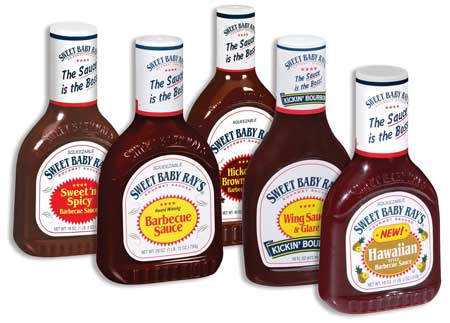 The Market
The Market
The barbecue sauce market, as defined by IRI, is relatively stable overall, according to IRI Infoscan data for the 52-week period ending May 17, 2015. During that period, sales measured $677 million, up 2.5% over a year ago. The top player, Chicago-based Sweet Baby Ray’s, amassed sales of $273 million, more than twice that of the next most successful sauce producer, Kraft Foods Group, which took in $125 million with its Kraft, BULL’S-EYE, and Garland Jack’s brand sauces. Private label sauce sales totaled $48 million, and HV Food Products Co., a subsidiary of The Clorox Co., came in just behind at $36 million for its KC Masterpiece brand.
Sprinkled throughout the remainder of the list are brands associated with celebrity chefs and barbecue restaurants; Guy Fieri’s barbecue sauces may be popular because of the connection consumers have with his Food Network show Diners, Drive-Ins and Dives, in which he travels the country discovering what locals love to eat. Chain restaurants and regionally famous local joints are also represented: Montgomery Inn from Ohio, Dinosaur Bar-B-Que from New York, and Sonny’s Real Pit Bar-B-Q in the Southeast. Perhaps consumers associate the success of these institutions with the promise of great flavor or consider purchasing these products a less expensive way to “visit” the restaurants. Or, in some cases, diners may choose to purchase these sauces as a way to bring their restaurant experience home; across the country, famed barbecue joints bottle and sell their sauces and rubs in-house, online, or in grocery stores, including Aaron Franklin’s hugely popular Austin-based Franklin Barbecue and Chicago’s Lillie’s Q.
Consumers enjoy barbecue in restaurants—the barbecue menu type is the 15th most popular nationwide, according to CHD Expert data (CHD Expert 2015), and 64% of respondents deemed barbecue as a perennial favorite in the National Restaurant Association’s 2015 Culinary Forecast (NRA 2015). These restaurants expose diners to globally influenced flavors, regional variations, and ultraspicy peppers, trends that speak to a sense of place and authenticity. According to Chicago research firm Mintel, “authenticity is another way operators and manufacturers can attract customers to try new dishes.” In a survey that asked respondents what would entice them to order items with new and unique flavors, Mintel found that 38% of Americans would be interested in items that are authentic representations of ethnic foods, such as Mexican Yucatán soups, Peruvian food, and Indian curries. Additionally, 59% of adults pointed to spiciness as a driver for trying new foods, though 39% prefer the heat level be specified on menus and labels (Mintel 2014a).
“Offerings at the restaurant level are where we often see the beginning of new flavor introductions that carry through to the retail packaged goods sector,” observes Gary Augustine, executive director, market development, for Kalsec, Kalamazoo, Mich. “Consumers frequently and commonly now experiment with new sources of heat in a sauce or marinade on a protein source to enhance the restaurant dining experience.” According to a team from Innova Flavors, Lombard, Ill.—Dafne Diez de Medina, vice-president of R&D and innovation; Cynthia Clery, senior principal food scientist; and Daniela Garza-Sokolowski, director of marketing—the move from dining out to the dining room is happening even more quickly now. In recent years, they have noticed that the window of adoption is getting shorter, with products appearing in restaurants and quickly after in retail.
--- PAGE BREAK ---
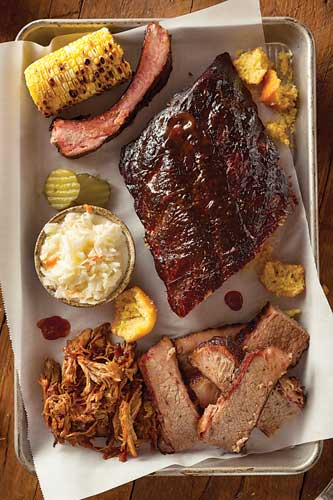 From Menu to Shelf
From Menu to Shelf
If restaurants are driving retail, what trends are actually showing up on shelves? On cooking shows and in barbecue competitions, regional styles are highly regarded, and the same holds true for bottled barbecue sauces. Many of the major brands offer a variety of regionally inspired sauces, including BULL’S-EYE, KC Masterpiece, and Cattlemen’s Master’s Reserve, while others, such as Sweet Baby Ray’s, provide recipes on their websites for using existing sauces to create regional flavor blends. And the number of regions continues to expand: Sweet Baby Ray’s recently introduced a Hawaiian-style sauce, and Open Pit, a Pinnacle Foods Group brand, offers instructions on its website for creating Chicago-, Pittsburgh-, Milwaukee-, and Indianapolis-style sauces.
Smaller brands have also taken this tack, narrowing their focus to just one region or city in some cases. Austin’s Own B-B-Q Sauce is made in Austin, Texas, and bills itself as a “true Texas original” on its website. Cowtown Barbeque Products, a Kansas City company, was launched after its signature sauce won the American Royal Barbecue Sauce Contest, a local competition that originated in 1899. When it comes to regional sauces, tradition is important, but since so many companies have embraced this idea, manufacturers should look for a way to tweak their formulas to set themselves apart.
“When consumers are looking at barbecue sauces, they want authenticity based on the region of the sauce. If you are going to show them a Carolina-style sauce, they’re going to want to see a vinegar-based sauce,” explains Tara Zmuda, strategic research chef, Cargill dressings, sauces, and oils, Gainesville, Ga. “But, on the flip side, you also see our customers requesting barbecue sauces with a twist, such as adding in Dr Pepper syrup or coffee and beer flavors to give their sauce a piece of differentiation.”
Indeed, beer, liquor, and soda have proven popular additions to sauces. On the soda side, A&W BBQ Sauce and 7UP Citrus Marinade bring the familiar flavors of these beverages to their sauces. Fieri adds “tangy” root beer to a sauce that also contains molasses and smoke, and Sweet Baby Ray’s claims the jolt of caramel sweetness in its Cola-Q sauce adds an extra punch of flavor. My Fit Foods, a health-focused retail store concept based in Austin, incorporates kombucha—fizzy fermented tea—into the sauce that accompanies its shredded chicken dish.
According to Datassential research quoted by Nation’s Restaurant News, bourbon-infused barbecue appears on 32% more restaurant menus than it did four years ago. Jack Daniel’s includes whiskey in its full range of sauces, and Stone Brewing Co. and Budweiser incorporate beer into each of their varieties. Other brands incorporate the alcohol into just a few of their products. Rufus Teague, Shawnee, Kan., offers a Whiskey Maple and its new Apple Mash, a sauce infused with moonshine and apple flavors. Hak’s Chipotle Bourbon combines bold bourbon flavor with a peppery kick, and all three varieties in the Open Pit Thick & Sweet line of sauces include brown liquor: Sweet Spiced Rum, Brown Sugar Bourbon, and Apple Whiskey. Sweet Baby Ray’s offers a Kickin’ Bourbon Molasses Wing Sauce & Glaze, and it provides recipes for creating Whiskey BBQ, Spiced Rum, and Tequila Spice varieties on its foodservice site.
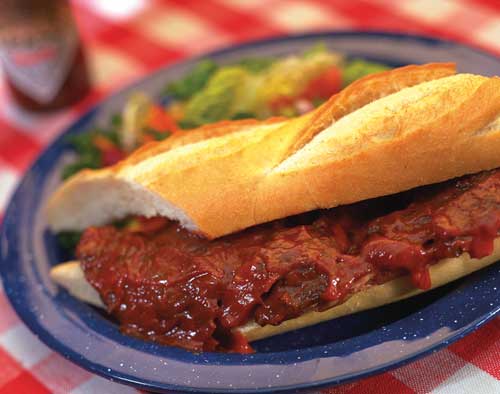 Fruit flavors often appear alongside alcohol for balance, and they also team up often with a variety of peppers to cut or complement their heat. Examples include Schlotterbeck & Foss Pineapple Jalapeño and Raspberry Chipotle, Bronco Bob’s Roasted Mango, and Brownwood Farms Cherry Barbeque Sauce, which the company’s website says “delivers both the sweet and the heat.” In fact, the idea of sweet heat is seen repeatedly across barbecue.
Fruit flavors often appear alongside alcohol for balance, and they also team up often with a variety of peppers to cut or complement their heat. Examples include Schlotterbeck & Foss Pineapple Jalapeño and Raspberry Chipotle, Bronco Bob’s Roasted Mango, and Brownwood Farms Cherry Barbeque Sauce, which the company’s website says “delivers both the sweet and the heat.” In fact, the idea of sweet heat is seen repeatedly across barbecue.
“Sweet heat, citrus, and herbal combinations with specialty pepper varieties are currently the most popular [flavor combinations],” says Kalsec’s Augustine. “Examples would include honey chipotle, mango habanero, and sweet ginger.” On shelves, this can be seen in Weber Sweet ‘N Spicy, Stubb’s Sweet Heat and Sweet Black Pepper, and Sweet Baby Ray’s Sweet ‘n Spicy. Additionally, smoky flavors from woods such as hickory, mesquite, cherry, and applewood appear in sauces across brands, tapping into the association these woods have with open fires and long periods slow roasting in a smoker. According to Judson McLester, executive chef and ingredient sales manager, Tabasco brand, McIlhenny Co., Avery Island, La., smoke hybrids may be the next flavor innovation in barbecue sauces; he points to the idea of using orange peels, coffee beans, and exotic woods to build flavor as a trend to watch.
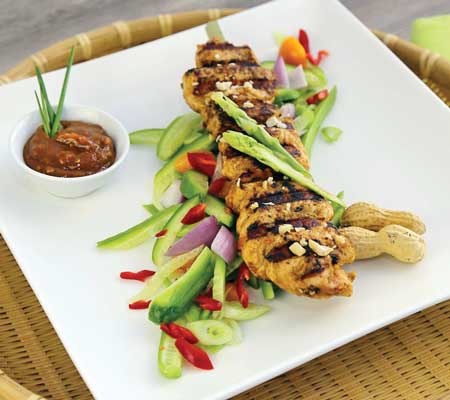 A World of Flavor
A World of Flavor
“Barbecue is all about flavor,” observes McLester, “and not only is it an American trend but a fast-growing global trend as well.” Around the world, he says, chefs in countries such as England and Poland are working hard to re-create American barbecue, and here in the United States, global flavors have begun creeping into barbecue in exchange. It makes sense, since grilling and slow-roasting are techniques celebrated around the world, and with more and more diners embracing new and unique flavors in restaurants (Mintel 2014a), the time is ripe for the American definition of barbecue to expand to incorporate these styles and flavors.
“Today’s consumers want big, bold flavors and are more adventurous with the foods they eat,” explains McLester. “More and more [consumers], especially Millennials, crave the authentic, bold flavors of ethnic cuisine like Thai, Indian, Ethiopian, and South American food.” To meet the demand for these flavors, Wixon created a line of rubs and marinades centered around global grilling. Its Bombay Chicken Marinade blends garlic and spices, and its Peruvian Aji Pepper Rub combines a range of peppers—including aji panca, aji amarillo, jalapeño, and red and green bell peppers—with turmeric, orange peel, and lime juice.
According to the NRA’s Culinary Forecast, ethnic/street food–inspired appetizers are No. 3 on the top appetizer trends predicted for this year, and both authentic ethnic cuisine and regional ethnic cuisine top the list of ethnic flavor trends (NRA 2015). Ethnic barbecue, particularly Korean barbecue, has become extremely popular, driven at least in part by consumer interest in street food, says Wixon’s Holman.
Interestingly, although San-J International, Richmond, Va., recently introduced a gluten-free tamari-based Asian BBQ sauce, sauces expressly intended for making Asian barbecue dishes have not proliferated on supermarket shelves. According to Misako Binford, marketing manager at San-J, “Consumers seem to be learning more about using existing Asian sauces for their grilling and barbecuing,” incorporating teriyaki, soy, and other sauces into marinades. Additionally, Kikkoman recently ran a television spot promoting its soy sauce as an ideal marinade ingredient.
--- PAGE BREAK ---
Balancing Heat and Flavor
Many of the global flavor profiles surging in popularity are also big on heat, mainly in the form of peppers, something that consumers are increasingly embracing on restaurant menus. According to a recent survey conducted by Kalsec, 80% of consumers now enjoy hot and spicy foods, with 56% eating them at least once a week. Respondents pointed to jalapeño, cayenne, and chipotle as their preferred peppers, but in Europe, habanero, poblano, and peri peri have also gained popularity, according to Innova Market Insights data from 2015 (Kalsec 2015).
According to Mintel, consumers are still getting to know different regional peppers, and 33% of Americans would like menu items to call out the specific peppers being used in dishes (Mintel 2014a). “Different peppers and spices yield specific responses in the mouth, throat, and tongue,” explains McLester. He adds that heat is important in barbecue sauces because it allows the taste to linger. “By utilizing a combination of spices, you can create a three-dimensional, all-encompassing warming sensation for the consumer to experience,” he says.
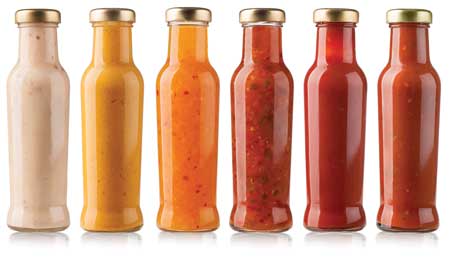 A variety of Tabasco ingredients can assist with building nuanced heat; Tabasco Brand Original Red Sauce works well in wet rubs, marinades, and sauces, and the new Spray Dry Flavor can be used in those applications as well as in dry rubs and other dry flavor formats. The company also offers a rich, smoky Chipotle Pepper Sauce and a milder Green Jalapeño Pepper Sauce for use in wet applications.
A variety of Tabasco ingredients can assist with building nuanced heat; Tabasco Brand Original Red Sauce works well in wet rubs, marinades, and sauces, and the new Spray Dry Flavor can be used in those applications as well as in dry rubs and other dry flavor formats. The company also offers a rich, smoky Chipotle Pepper Sauce and a milder Green Jalapeño Pepper Sauce for use in wet applications.
While heat appears to be popular across demographics, it may be particularly important to Baby Boomers, whose changing palate requires hotter and hotter foods as they age and their taste buds dull, says Holman. She adds that the “influx and proliferation of Hispanic consumers and their preferences … have driven awareness and trial of hotter foods.” According to Kalsec’s Augustine, sauces, marinades, and rubs allow consumers to experiment with these bold, unique flavors with minimal investment and risk.
Redefining Comfort Food
With more and more consumers concerned about the ingredients in the foods they eat—and feed to their children—the time is right for manufacturers to tweak their barbecue product formulations. “Barbecue needs to get healthy,” says Holman. She observes that many consumers create their own sauces, perhaps in order to control the type and quality of their ingredients. According to the team at Innova Flavors, consumers may not even be aware to what degree health claims drive their purchases, but these considerations are operating behind the scenes when consumers choose sauces. “Better for you is a concept that is mostly in the back of consumers’ mind when making a product selection,” they say. “The challenge for processors is developing products that address all needs and concerns from consumers and taste great.”
According to Mintel, roughly 37% of consumers who use sauces, marinades, dressings, or dry seasoning mixes were steered by no additives/preservatives claims to choose one brand over another, and the percentage of respondents who report that low-allergen and gluten-free claims motivate their sauce purchases has continued to rise over the last four years (Mintel 2014b). Furthermore, with sales of gluten-free products expected to grow significantly through 2017, Mintel suggests all brands should consider retooling their products or creating new products without gluten to appeal to these consumers (Mintel 2014b).
 Some companies have already focused on formulating products free from potential allergens and potentially undesirable ingredients. San-J’s tamari-based products are created through a process that does not include wheat, and Frutarom, Haifa, Israel, combines ingredients that are high in glutamates to mimic the umami notes of monosodium glutamate and hydrolyzed vegetable proteins, which some consumers are trying to avoid. One sauce company, Meatsmack, Chatham, Ill., proudly asserts that it only uses all-natural ingredients in its products. It eschews liquid smoke, which it claims many manufacturers use to achieve smoky flavor in sauces, and incorporates Scotch whiskey for smokiness instead.
Some companies have already focused on formulating products free from potential allergens and potentially undesirable ingredients. San-J’s tamari-based products are created through a process that does not include wheat, and Frutarom, Haifa, Israel, combines ingredients that are high in glutamates to mimic the umami notes of monosodium glutamate and hydrolyzed vegetable proteins, which some consumers are trying to avoid. One sauce company, Meatsmack, Chatham, Ill., proudly asserts that it only uses all-natural ingredients in its products. It eschews liquid smoke, which it claims many manufacturers use to achieve smoky flavor in sauces, and incorporates Scotch whiskey for smokiness instead.
With the exception of Carolina-style, barbecue sauce is known for its sweetness, but many consumers are looking to reduce their sugar intake and/or avoid high fructose corn syrup (HFCS). However, according to Zmuda, “Without a sweetener, most barbecue sauces wouldn’t be balanced or taste like the barbecue sauces we are all familiar with.”
To create a clean label sauce with lower sugar levels, manufacturers have some options. “Honey, blackstrap molasses, and maple syrup are sweeteners that are used regularly in sauces,” says Melody Blount, senior product development scientist for Cargill, “but fruit juice concentrates could also be considered for sauces and marinades.” She also suggests brown sugar, cane syrup, sucrose, and honey for creating cleaner label products without HFCS.
According to Agnes Lapinska, marketing manager, savory, at Ingredion, Westchester, Ill., tapioca syrup behaves similarly to HFCS and has a similar flavor profile. Because removing sugar affects the texture and viscosity of sauces, she also suggests Ingredion’s DIAL-IN Sweetness program, which allows formulators to maintain the sweetness level and texture of a full-sugar sauce. Ingredion also supplies solutions intended to achieve the same results that combine its ENLITEN Reb A stevia with NOVATION functional native starches.
--- PAGE BREAK ---
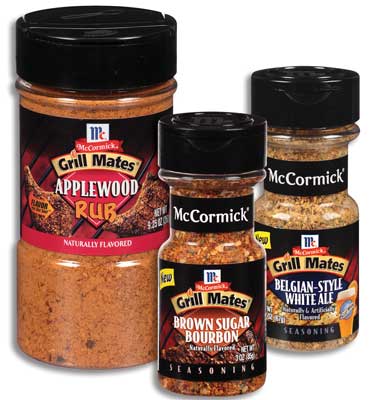 In addition, rubs and spice blends offer a way to punch up flavor without adding sugar—though many do contain salt. McCormick & Co., Sparks, Md.—which recently acquired the Stubb’s brand line of barbecue sauces—echoes many of the flavor trends seen in barbecue sauces in its line of Grill Mates Seasoning Blends, some of which are available at 25% reduced sodium. Options include Fiery 5 Pepper, Belgian-Style White Ale, and Smokehouse Maple. Meanwhile, its Grill Mates Dry Rubs run the gamut of barbecue styles, from Slow & Low Smokin’ Texas BBQ to Applewood to Sweet & Smoky.
In addition, rubs and spice blends offer a way to punch up flavor without adding sugar—though many do contain salt. McCormick & Co., Sparks, Md.—which recently acquired the Stubb’s brand line of barbecue sauces—echoes many of the flavor trends seen in barbecue sauces in its line of Grill Mates Seasoning Blends, some of which are available at 25% reduced sodium. Options include Fiery 5 Pepper, Belgian-Style White Ale, and Smokehouse Maple. Meanwhile, its Grill Mates Dry Rubs run the gamut of barbecue styles, from Slow & Low Smokin’ Texas BBQ to Applewood to Sweet & Smoky.
Category Challenges and Opportunities
Manufacturers looking to grow within this category or new, smaller players hoping to break into the market might find this proposition difficult. The leading brands of sauces and condiments enjoy strong consumer loyalty, and when consumers change their purchasing patterns, it tends to be toward cheaper generic versions rather than to other equally expensive brands (IBISWorld 2015). The fact that restaurant visits increase during prosperous times also detracts from the amount of sauces being purchased, as does, to a smaller degree, the decrease in families with children, who tend to consume more of these products (IBISWorld 2015). In addition, barbecue is a seasonal product, with summer the most popular time for grilling (Mintel 2015), and with possible declines in meat consumption, especially red meat, as advocated by the 2015 Dietary Guidelines Committee recommendations, barbecue sauce consumption may also slow (IBISWorld 2015).
However, an increasing number of consumers are embracing home cooking—according to Mintel, nearly 40% of consumers identify as foodies, and these home chefs are looking for unique flavors and gourmet products (Mintel 2014b). A 2015 survey conducted by Weber found that 81% of grillers believe the food they make at home is the same or better than what they can find at restaurants, and 82% of these respondents say they keep two or more barbecue sauces at home (Weber 2015).
So how can manufacturers appeal to home chefs who want to create great food at home without breaking the bank in order to do so? For starters, they might explore ways to give their sauces a premium feel without increasing their price point; Kraft Slow-Simmered sauce has the look and feel of an artisanal product without the price tag. Holman suggests that securing the endorsement of a celebrity chef or barbecue expert can help a product stand out, and the Pork & Mindy’s line created by Food Network star Jeff Mauro and his competitive barbecuer partner addresses both of these—and at a price point of just $5. As Mauro told the Chicago Tribune, “There are $10 barbecue sauces on the market, and that’s crazy.” His brand also focuses on promoting art programs, providing another point of differentiation.
Secondly, manufacturers looking to build their customer base might consider finding better ways to satisfy their customers. According to Mintel, half of respondents who use cooking sauces, marinades, and dry spices report that they mix ingredients themselves to create sauces, which “indicates that many users do not find the sauces and marinades sold at stores to suit their tastes” (Mintel 2014b). Holman advises companies to increase the amount of product sampling they do in grocery stores to incorporate this feedback into their products.
However they choose to do so, companies must continue to focus on providing consumers with the hottest new trends while maintaining the quality, consistency, and value of their products. “Consumers are looking for unique, great-tasting barbecue,” says Holman. “They want a sure thing—that when they buy it, it is going to meet or exceed their expectations for taste … because in the end, it is all about taste.”
Barbecue Beyond the Dinner Plate
On supermarket shelves, the flavors associated with barbecue have shown up in a range of food products. There are the traditional applications—frozen chicken tenders and wings, refrigerated pulled pork and chicken, and the entrée in frozen meals—but barbecue is also appearing in deli meats such as Dietz & Watson Honey Barbecue chicken and even in meat alternatives such as gardein Sweet and Tangy Barbecue Wings.
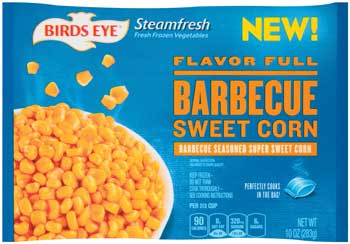 Additionally, barbecue has migrated into side dishes such as Knorr Asian BBQ rice mix and Birds Eye Buffalo Cauliflower and Barbecue Sweet Corn frozen vegetables, and it stars in French’s new Twangy BBQ Mustard Sauce, which includes aged cayenne peppers, apple cider vinegar, and molasses.
Additionally, barbecue has migrated into side dishes such as Knorr Asian BBQ rice mix and Birds Eye Buffalo Cauliflower and Barbecue Sweet Corn frozen vegetables, and it stars in French’s new Twangy BBQ Mustard Sauce, which includes aged cayenne peppers, apple cider vinegar, and molasses.
Barbecue has also enjoyed increasing popularity in snack applications; according to Wixon’s Kim Holman, “Barbecue has crossed categories beyond the sauce. It has become a staple flavor for snacks. This has helped drive awareness and trial of barbecue in general.” Last year 7-Eleven launched a line of regional barbecue snacks, and Wixon itself developed several ethnic barbecue–inspired snack concepts, including Argentinian Asado Sweet Potato Chips and Russian Shashlik Potato Balls.
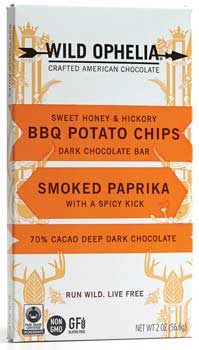 While many consumers have likely tried barbecue-flavored potato chips, the emergence of better-for-you chip products has expanded barbecue flavors into this realm, in products such as LesserEvil Chia Crisps, Bearitos BBQ Black Bean Corn Chips, Lundberg Santa Fe Barbecue Rice Chips, and Simply 7 Barbecue Quinoa Chips. Barbecue flavors are also found in pretzels, crackers, and even dairy; Old Fashioned Foods recently introduced Barbecue Cheese Snack Sticks. There remain opportunities for barbecue to expand even further, as there do not seem to be packaged popcorn products, rice cakes, or nut mixes containing barbecue flavors.
While many consumers have likely tried barbecue-flavored potato chips, the emergence of better-for-you chip products has expanded barbecue flavors into this realm, in products such as LesserEvil Chia Crisps, Bearitos BBQ Black Bean Corn Chips, Lundberg Santa Fe Barbecue Rice Chips, and Simply 7 Barbecue Quinoa Chips. Barbecue flavors are also found in pretzels, crackers, and even dairy; Old Fashioned Foods recently introduced Barbecue Cheese Snack Sticks. There remain opportunities for barbecue to expand even further, as there do not seem to be packaged popcorn products, rice cakes, or nut mixes containing barbecue flavors.
Perhaps the biggest surprise? Barbecue has also been spotted in desserts: Wild Ophelia created a premium dark chocolate bar with hickory and honey barbecue potato chips and smoked paprika, a candy bar balancing sweet and savory flavors.
“Interested in the chemistry behind barbecuing meat? Watch a Food Facts video by IFT spokesperson and America’s Test Kitchen science editor Guy Crosby.”
Melanie Zanoza Bartelme is associate editor of Food Technology magazine ([email protected])
References
CHD Expert. 2015. Barbecue Restaurant Data. June. CHD Expert, Chicago. chd-expert.com.
Filloon, W. 2015. “Chef Michael Symon Says He’s Inventing a New Style of Barbecue.” Eater, June 24. http://www.eater.com/2015/6/24/8838439/michael-symon-cleveland-style-barbecue.
IBISWorld. 2015. Industry Report 31194: Seasoning, Sauce and Condiment Production in the U.S. April. IBISWorld, New York. ibisworld.com.
Kalsec. 2015. Survey: Hot and Spicy Trends. Kalsec, Kalamazoo, Mich. kalsec.com.
Mintel. 2014a. Innovation on the Menu: Flavor Trends—U.S: Drivers to Try New Menu Items with New Flavors. June. Mintel Group, Chicago. mintel.com.
Mintel. 2014b. Cooking Sauces, Marinades and Spices—U.S. Dec.
Mintel. 2015. Grilling and Barbecuing—U.S. March.
NRA. 2015. 2015 Culinary Forecast. National Restaurant Association, Chicago. restaurant.org/foodtrends.
Weber. 2015. Survey: Summertime Grillin’. Weber Sauces & Seasonings, Cordova, Tenn. weberseasonings.com.
Ziezulewicz, G. 2015. “Food Network star Jeff Mauro launches barbecue sauce line at Mariano’s.” Chicago Tribune, June 29.
